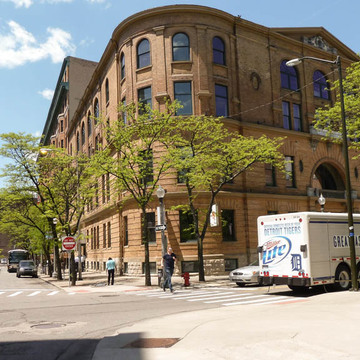You are here
Carr Cultural Center (Harmonie Club)
In 1849 four German immigrants formed the Gesang-Verein Harmonie to meet and sing German lieder. The club was chartered in 1852; in 1875 the organization incorporated and built a clubhouse that burned in 1893. The present club was designed by Raseman (b. 1855), who was one of several German American Detroit architects to whom the design competition for the building was open. The Harmonie Club is a monumental four-story Beaux-Arts classical design that faces Harmonie Park. The light yellowish-brown brick walls of the building rise above a rusticated stone foundation. They are interrupted with belt courses and decorative pilasters. The central Ionic order entrance is beneath a broad arch that extends through the second floor. The club contained dining rooms, lounges, meeting rooms, a bowling alley, and two large auditoriums. The Downtown Development Authority agreed in 2006 to buy Harmonie Club, the centerpiece of the district, and several other buildings.
Writing Credits
If SAH Archipedia has been useful to you, please consider supporting it.
SAH Archipedia tells the story of the United States through its buildings, landscapes, and cities. This freely available resource empowers the public with authoritative knowledge that deepens their understanding and appreciation of the built environment. But the Society of Architectural Historians, which created SAH Archipedia with University of Virginia Press, needs your support to maintain the high-caliber research, writing, photography, cartography, editing, design, and programming that make SAH Archipedia a trusted online resource available to all who value the history of place, heritage tourism, and learning.









